Investigation of Changes in the Structural-Phase State and the Efficiency of Hardening of 30CrMnSiA Steel by the Method of Electrolytic Plasma Thermocyclic Surface Treatment
Abstract
:1. Introduction
2. Materials and Methods
3. Results and Discussion
4. Conclusions
- –
- It was established that as the number of cycles of electrolytic plasma hardening increases, the transformation of large-needle martensite into needle martensite and the formation of iron carbides occurs, and the thickness of the reinforced layer increases significantly.
- –
- It was determined that the microstructure of 30CrMnSiA steel after electrolytic plasma thermocyclic hardening has a characteristic zonal structure, which is conditionally divided into three zones: zone 1 hardens with a martensitic morphological component with a thickness of up to 3 mm; zone 2 is thermal influence, where the structure consists of martensite and pearlite; and zone 3 is a matrix with a ferrite–pearlite structural component.
- –
- It was established that surface hardening creates a gradient microstructure in the plasma hardening region with a predominantly martensitic microstructure. In the hardened zone, a maximum hardness of approximately 9.1 GPa was obtained, which is three times higher than that in the main material.
- –
- It was found that the electrolytic plasma thermocyclic hardening of 30CrMnSiA steel has a positive effect on tribological parameters, so the value of the sliding friction coefficient decreased by 2.4 times compared to the original sample.
5. Patents
Author Contributions
Funding
Institutional Review Board Statement
Informed Consent Statement
Data Availability Statement
Conflicts of Interest
References
- Belkin, P.N.; Kusmanov, S.A. Plasma electrolytic hardening of steels: Review. Surf. Eng. Appl. Electrochem. 2016, 52, 531–546. [Google Scholar] [CrossRef]
- Pantelis, D.I.; Bouyiouri, E.; Kouloumbi, N.; Vassiliou, P.; Koutsomichalis, A. Wear and corrosion resistance of laser surface hardened structural steel. Surf. Coat. Technol. 2002, 161, 125–134. [Google Scholar] [CrossRef]
- Kulka, M.; Pertek, A. Laser surface modification of carburized and borocarburized 15CrNi6 steel. Mater. Charact. 2007, 58, 461–470. [Google Scholar] [CrossRef]
- Skeeba, V.Y.; Ivancivsky, V.V.; Martyushev, N.V. Peculiarities of High-Energy Induction Heating during Surface Hardening in Hybrid Processing Conditions. Metals 2021, 11, 1354. [Google Scholar] [CrossRef]
- Iliescu, M.; Roşu, M.-M.; Căpăţină, D. Optimization of the Induction Process on Light Gauge Steel Profiles Used in Metallic Framed Sustainable Eco-Constructions. Sustainability 2019, 11, 6686. [Google Scholar] [CrossRef] [Green Version]
- Popova, N.A.; Zhurerova, L.G.; Nikonenko, E.L.; Skakov, M.K. Effect of plasma electrolytic nitrocarburizing on phase composition of 0.3C-1Mn-1Si-fe steel. Inorg. Mater. Appl. Res. 2017, 8, 130–135. [Google Scholar] [CrossRef]
- Zhu, X. Effect of fast cooling on mechanical properties of continuous annealed cold rolled ultra high strength steel. Cailiao Rechuli Xuebao Trans. 2006, 27, 49–52. [Google Scholar]
- Hurtado-Delgado, E.; Huerta-Larumbe, L.; Miranda-Pérez, A.; Aguirre-Sánchez, Á. Microcracks reduction in laser hardened layers of ductile iron. Coatings 2021, 11, 368. [Google Scholar] [CrossRef]
- Rakhadilov, B.K.; Buranich, V.V.; Satbayeva, Z.A.; Sagdoldina, Z.B.; Kozhanova, R.S.; Pogrebnjak, A.D. The cathodic electrolytic plasma hardening of the 20Cr2Ni4A chromium-nickel steel. J. Mater. Res. Technol. 2020, 9, 6969–6976. [Google Scholar] [CrossRef]
- Tyurin, Y.N.; Pogrebnjak, A.D. Electric heating using a liquid electrode. Surf. Coat. Technol. 2001, 142–144, 293–299. [Google Scholar] [CrossRef]
- Zhurerova, L.G.; Rakhadilov, B.K.; Popova, N.A.; Kylyshkanov, M.K.; Buranich, V.V.; Pogrebnjak, A.D. Effect of the PEN/C surface layer modification on the microstructure, mechanical and tribological properties of the 30CrMnSiA mild-carbon steel. J. Mater. Res. Technol. 2020, 9, 291–300. [Google Scholar] [CrossRef]
- Ayday, A.; Durman, M. Effect of different surface-heat-treatment methods on the surface properties of AISI 4140 steel. Mater. Tehnol. 2014, 48, 787–790. [Google Scholar]
- Rakhadilov, B.; Seitkhanova, A.; Satbayeva, Z.; Yerbolatova, G.; Icheva, Y.; Sagdoldina, Z. Investigation of the structural, mechanical and tribological properties of plasma electrolytic hardened chromium-nickel steel. Lubricants 2021, 9, 108. [Google Scholar] [CrossRef]
- Tabiyeva, Y.Y.; Rakhadilov, B.K.; Uazyrkhanova, G.K.; Zhurerova, L.G.; Maulit, A.; Baizhan, D. Surface modification of steel mark 2 electrolytic-plasma exposure. Eurasian J. Phys. Funct. Mater. 2019, 3, 355–362. [Google Scholar] [CrossRef]
- Kozlov, E.V.; Malinovskaya, V.A.; Popova, N.L.; Sizonenko, N.R.; Gromov, V.E. Formation of structure-phase states in gradient layers of 20X2H4A steel after nitrocementation. Steel Transl. 2007, 37, 986–988. [Google Scholar] [CrossRef]
- Rahadilov, B.K.; Zhurerova, L.G.; Sagdoldina, Z.B.; Kenesbekov, A.B.; Bayatanova, L.B. Morphological changes in the dislocation structure of structural steel 20GL after electrolytic-plasma hardening of the surface. J. Surf. Investig. 2021, 15, 408–413. [Google Scholar] [CrossRef]
- Rakhadilov, B.K.; Satbayeva, Z.A.; Wieleba, W.; Kylyshkanov, M.K.; Baizhan, D.R. Changes in structure and properties of structural chromonickel steels after plasma electrolyte hardening. News Natl. Acad. Sci. Repub. Kazakhstan 2021, 4, 76–82. [Google Scholar] [CrossRef]
- Ayday, A.; Kırsever, D.; Demirkıran, A.Ş. The effects of overlapping in electrolytic plasma hardening on wear behavior of carbon steel. Trans. Indian Inst. Met. 2022, 75, 27–33. [Google Scholar] [CrossRef]
- Rakhadilov, B.; Satbayeva, Z.; Baizhan, D. Effect of electrolytic-plasma surface strengthening on the structure and properties of steel 40kHN. In Proceedings of the 28th International Conference on Metallurgy and Materials (METAL), Brno, Czech Republic, 22–24 May 2019; pp. 950–955. [Google Scholar]
- Kumruoğlu, L.C.; Özel, A. Surface Modification of AISI 4140 Steel Using Electrolytic Plasma Thermocyclic Treatment. Mater. Manuf. Process. 2010, 25, 923–931. [Google Scholar] [CrossRef]
- Shi, L.; Cui, X.; Li, J.; Jin, G.; Liu, J.; Tian, H. Improving the wear resistance of heavy-duty gear steels by cyclic carburizing. Tribol. Int. 2022, 171, 107576. [Google Scholar] [CrossRef]
- Di Schino, A.; Testani, C. Heat Treatment of Steels. Metals 2021, 11, 1168. [Google Scholar] [CrossRef]
- Doudkin, M.; Kim, A.; Savelyev, A.; Zhileikin, M.; Gribb, V.; Mikhailovskaya, V. Modernization of the Metal Structure of the Grader Working Equipment. Int. Rev. Mech. Eng. 2020, 14, 1–8. [Google Scholar] [CrossRef]
- Dyakov, I.G.; Burov, S.V.; Belkin, P.N.; Rozanov, E.V.; Zhukov, S.A. Increasing wear and corrosion resistance of tool steel by anodic plasma electrolytic nitriding. Surf. Coat. Technol. 2019, 362, 124–131. [Google Scholar] [CrossRef]
- Rakhadilov, B.K.; Kozhanova, R.S.; Baizhan, D.; Zhurerova, L.G.; Yerbolatova, G.U.; Kalitova, A.A.; Zhanuzakova, L.N. Influence of plasma electrolytic hardening modes on the structure and properties of 65G steel. Eurasian J. Phys. Funct. Mater. 2021, 5, 209–221. [Google Scholar] [CrossRef]
- Rakhadilov, B.K.; Tabiyeva, Y.Y.; Uazyrkhanova, G.K.; Zhurerova, L.G.; Baizhan, D. Influence of electrolytic-plasma surface quenching on the structure and strength properties of ferritic-pearlite class wheel steel. Eurasian J. Phys. Funct. Mater. 2020, 4, 167–173. [Google Scholar] [CrossRef]
- Dayança, A.; Karaca, B.; Kumruoǧlu, L.C. The cathodic electrolytic plasma hardening of steel and cast iron based automotive camshafts. Acta Phys. Pol. A 2017, 131, 374–378. [Google Scholar] [CrossRef]
- Kusmanov, S.A.; Silkin, S.A.; Smirnov, A.A.; Belkin, P.N. Possibilities of increasing wear resistance of steel surface by plasma electrolytic treatment. Wear 2017, 386–387, 239–246. [Google Scholar] [CrossRef]
- Kozlov, E.; Popova, N.; Zhurerova, L.; Nikonenko, E.; Kalashnikov, M.; Skakov, M. Structural and phase transformations in 0.3C-1Cr-1Mn-1Si-fe steel after electrolytic plasma treatment. AIP Conf. Proc. 2016, 1783, 020112. [Google Scholar] [CrossRef]
- Rakhadilov, B.; Satbayeva, Z.; Ramankulov, S.; Shektibayev, N.; Zhurerova, L.; Popova, N.; Uazyrkhanova, G.; Sagdoldina, Z. Change of 0.34Cr-1Ni-Mo-Fe steel dislocation structure in plasma electrolyte hardening. Materials 2021, 14, 1928. [Google Scholar] [CrossRef] [PubMed]
- Rakhadilov, B.; Baizhan, D. Creation of bioceramic coatings on the surface of ti–6al–4v alloy by plasma electrolytic oxidation followed by gas detonation spraying. Coatings 2021, 11, 1433. [Google Scholar] [CrossRef]
- Kumruoglu, L.C.; Becerik, D.A.; Ozel, A.; Mimaroglu, A. Surface modification of medium carbon steel by using electrolytic plasma thermocyclic treatment. Mater. Manuf. Process. 2009, 24, 781–785. [Google Scholar] [CrossRef]
- Bayati, M.R.; Molaei, R.; Janghorban, K. Surface alloying of carbon steels from electrolytic plasma. Met. Sci. Heat Treat. 2011, 53, 91–94. [Google Scholar] [CrossRef]
- Oliver, W.; Pharr, G. An Improved Technique for Detemining Hardness and Elastic Modulus Using Load and Displacement Sensing Indentation Experiments. J. Mater. Res. 1992, 7, 1564–1583. [Google Scholar] [CrossRef]
- ArslanHafeez, M.; Usman, M.; Arshad, M.A.; AdeelUmer, M. Nanoindentation-Based Micro-Mechanical and Electrochemical Properties of Quench-Hardened, Tempered Low-Carbon Steel. Crystals 2020, 10, 508. [Google Scholar] [CrossRef]
- Aliofkhazraei, M.; Taheri, P.; Rouhaghdam, A.S.; Dehghanian, C. Systematic study of nanocrystalline plasma electrolytic nitrocarburising of 316L austenitic stainless steel for corrosion protection. J. Mater. Sci. Technol. 2007, 23, 665–671. [Google Scholar]
- Chen, J.; Zuo, Z.; Zhou, S.; Wang, X.; Chen, Y.; Ling, G. Study on the Compressive Stress Retention in Quenched Cam of 100Cr6 Steel Based on Coupled Thermomechanical and Metallurgical Modeling. Materials 2021, 14, 5912. [Google Scholar] [CrossRef] [PubMed]
- Merah, N.; Abdul Azeem, M.; Abubaker, H.M.; Al-Badour, F.; Albinmousa, J.; Sorour, A.A. Friction Stir Processing Influence on Microstructure, Mechanical, and Corrosion Behavior of Steels: A Review. Materials 2021, 14, 5023. [Google Scholar] [CrossRef]
- Eres-Castellanos, A.; Garcia-Mateo, C.; Caballero, F.G. Future Trends on Displacive Stress and Strain Induced Transformations in Steels. Metals 2021, 11, 299. [Google Scholar] [CrossRef]
- Litovchenko, I.; Akkuzin, S.; Polekhina, N.; Almaeva, K.; Moskvichev, E. Structural Transformations and Mechanical Properties of Metastable Austenitic Steel under High Temperature Thermomechanical Treatment. Metals 2021, 11, 645. [Google Scholar] [CrossRef]
- Li, J.; Yan, H.; Li, S.; Zhang, Y.; Wu, S. Sliding Friction and Wear Properties of 40CrNiMo Steel after Laser Hardening against GCr15 Steel under Oil Lubrication. Coatings 2022, 12, 604. [Google Scholar] [CrossRef]
- Berladir, K.; Hatala, M.; Hovorun, T.; Pavlenko, I.; Ivanov, V.; Botko, F.; Gusak, O. Impact of Nitrocarburizing on Hardening of Reciprocating Compressor’s Valves. Coatings 2022, 12, 574. [Google Scholar] [CrossRef]
- Fricke, L.V.; Gerstein, G.; Kotzbauer, A.; Breidenstein, B.; Barton, S.; Maier, H.J. High Strain Rate and Stress-State-Dependent Martensite Transformation in AISI 304 at Low Temperatures. Metals 2022, 12, 747. [Google Scholar] [CrossRef]
- Savrai, R.A.; Skorynina, P.A. Structural-phase transformations and changes in the properties of AISI 321 stainless steel induced by liquid carburizing at low temperature. Surf. Coat. Technol. 2022, 443, 128613. [Google Scholar] [CrossRef]
- Kim, A.; Doudkin, M.; Vavilov, A.; Guryanov, G. New vibroscreen with additional feed elements. Arch. Civ. Mech. Eng. 2017, 17, 786–794. [Google Scholar] [CrossRef]
- Tarakci, M.; Korkmaz, K.; Gencer, Y.; Usta, M. Plasma electrolytic surface carburizing and hardening of pure iron. Surf. Coat. Technol. 2005, 199, 205–212. [Google Scholar] [CrossRef]
- Gharbi, A.; Bouhamla, K.; Ghelloudj, O.; Ramoul, C.E.; Berdjane, D.; Chettouh, S.; Remili, S. Heat Treatment Effect on the Microstructural, Hardness and Tribological Behavior of A105 Medium Carbon Steel. Defect Diffus. Forum 2021, 406, 419–429. [Google Scholar] [CrossRef]
- Rakhadilov, B.K.; Baizhan, D.R.; Sagdoldina, Z.B.; Buitkenov, D.B.; Maulet, M. Phase composition and structure of composite Ti/HA coatings synthesized by detonation spraying. AIP Conf. Proc. 2020, 2297, 020022. [Google Scholar] [CrossRef]
- Rakhadilov, B.K.; Stepanova, O.A.; Sagdoldina, Z.B.; Satbayeva, Z.A. Method for Hardening Steel Products. KZ Utility Model Patent No. 4891; Application No. 18.09.2018, 28 April 2020. [Google Scholar]
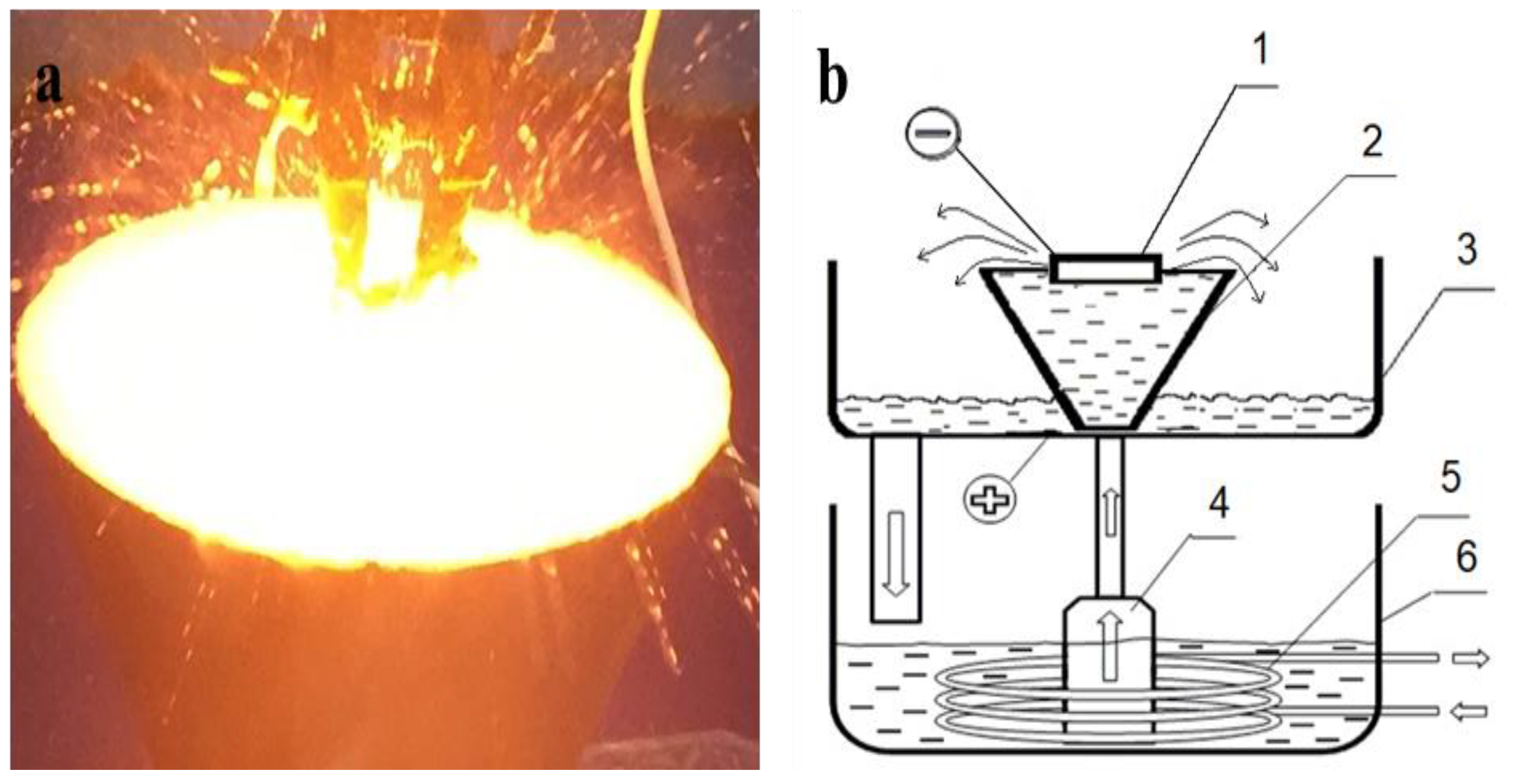
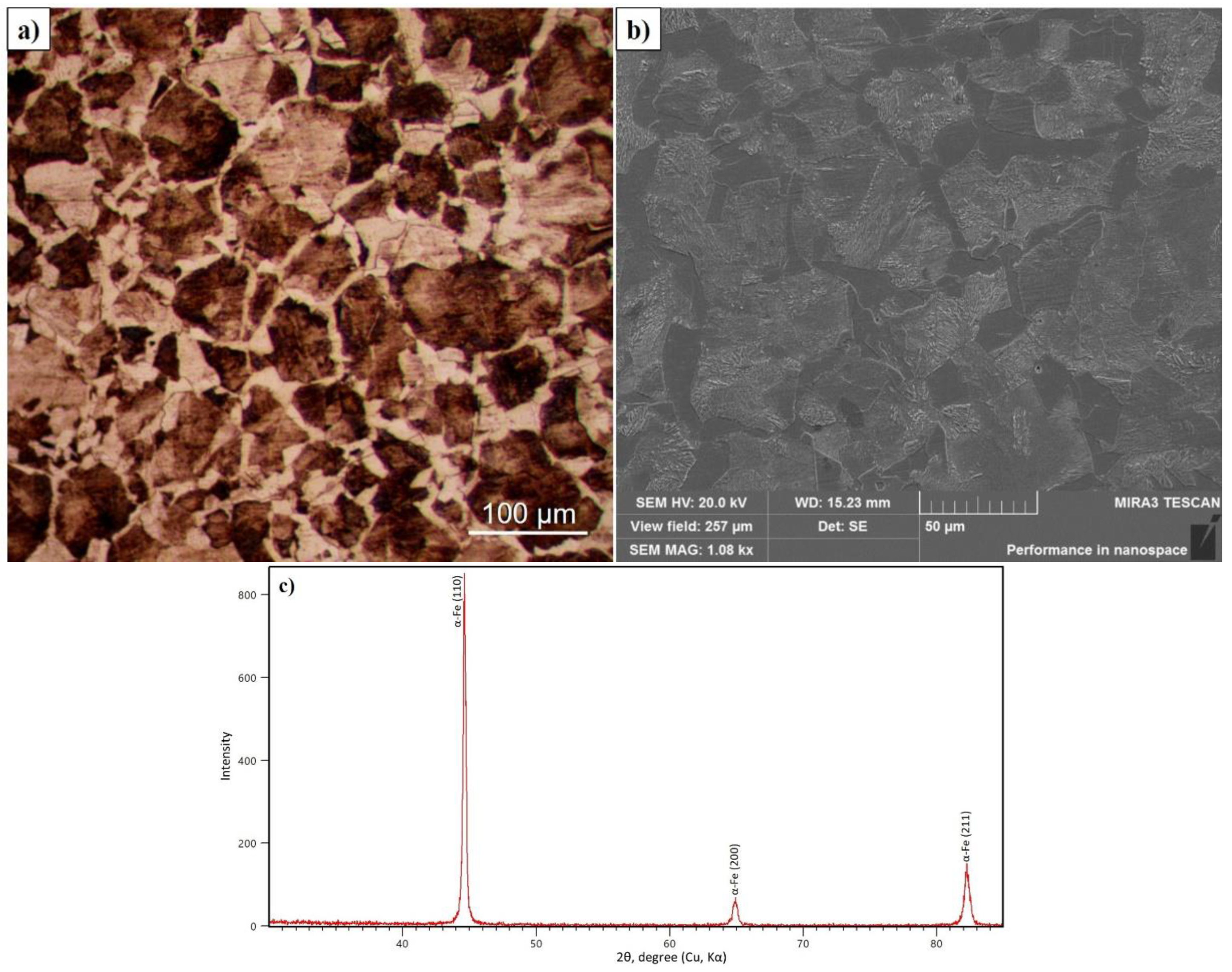

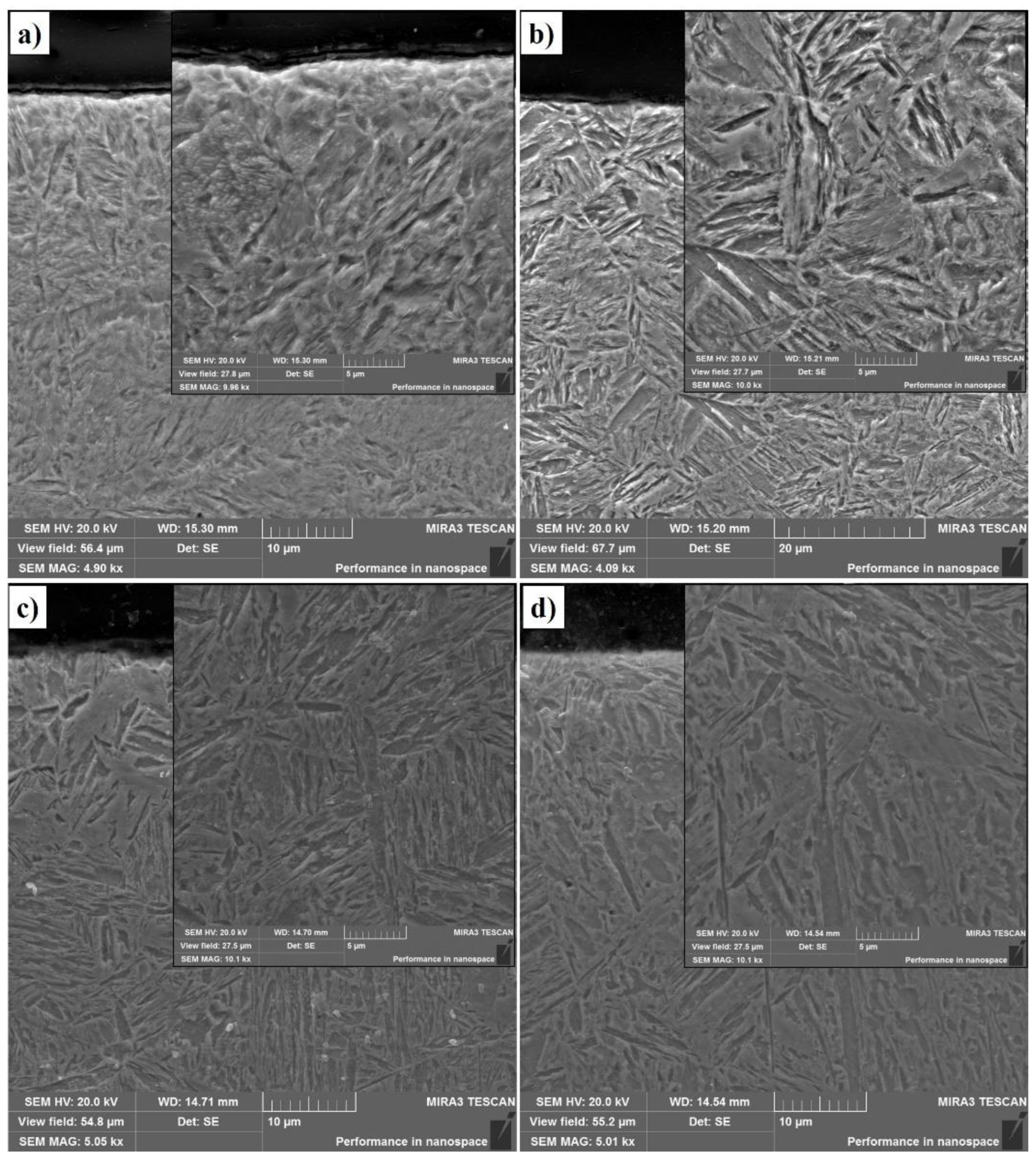

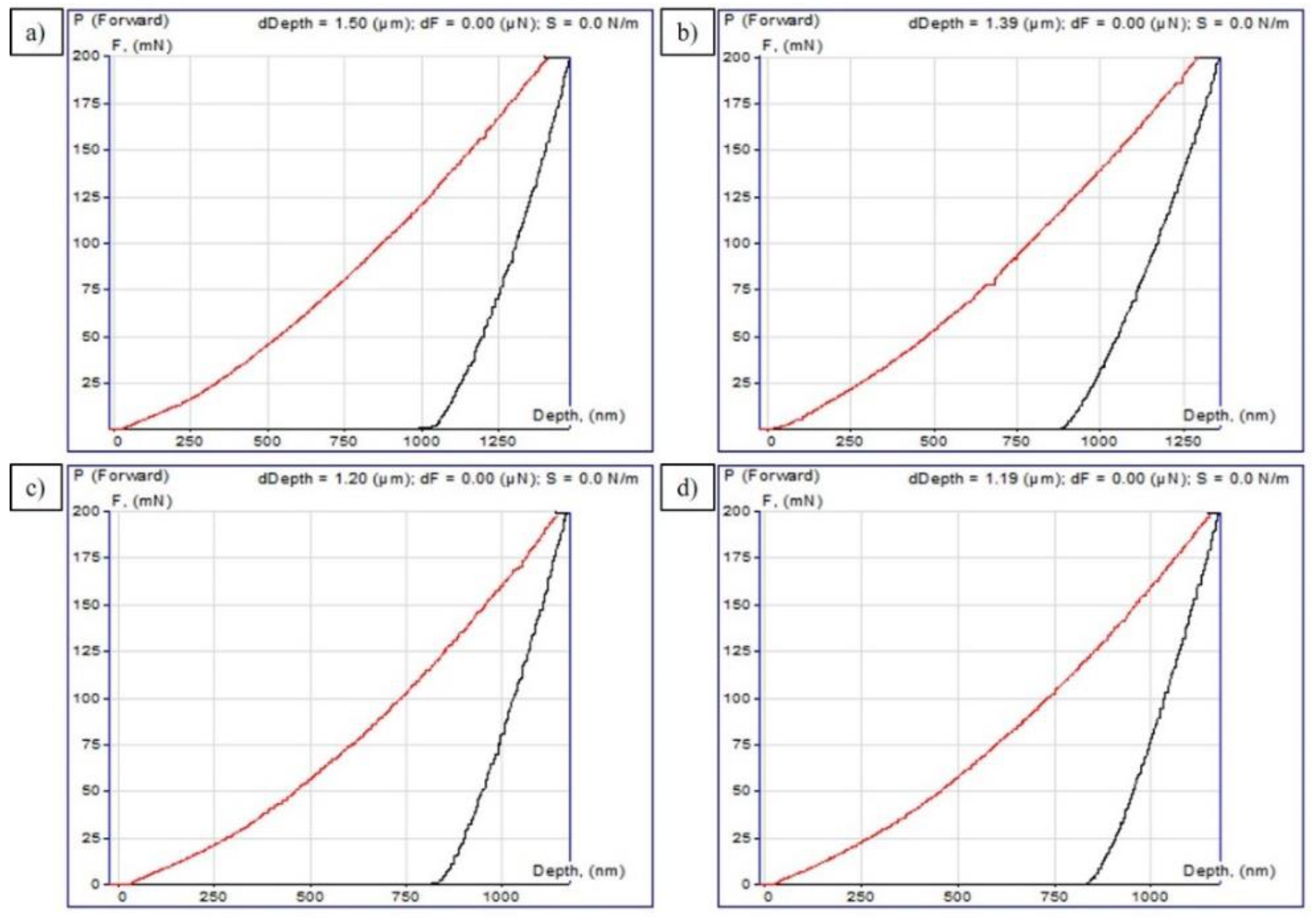
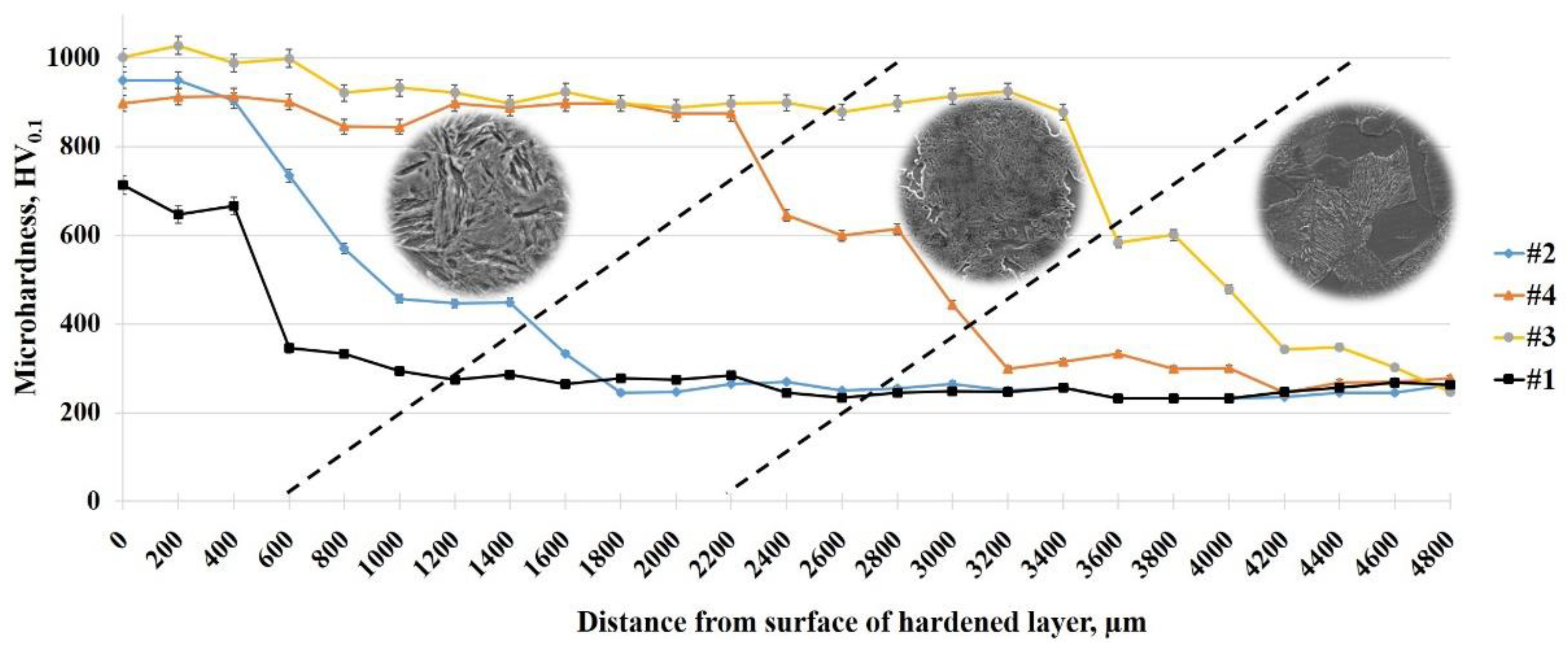

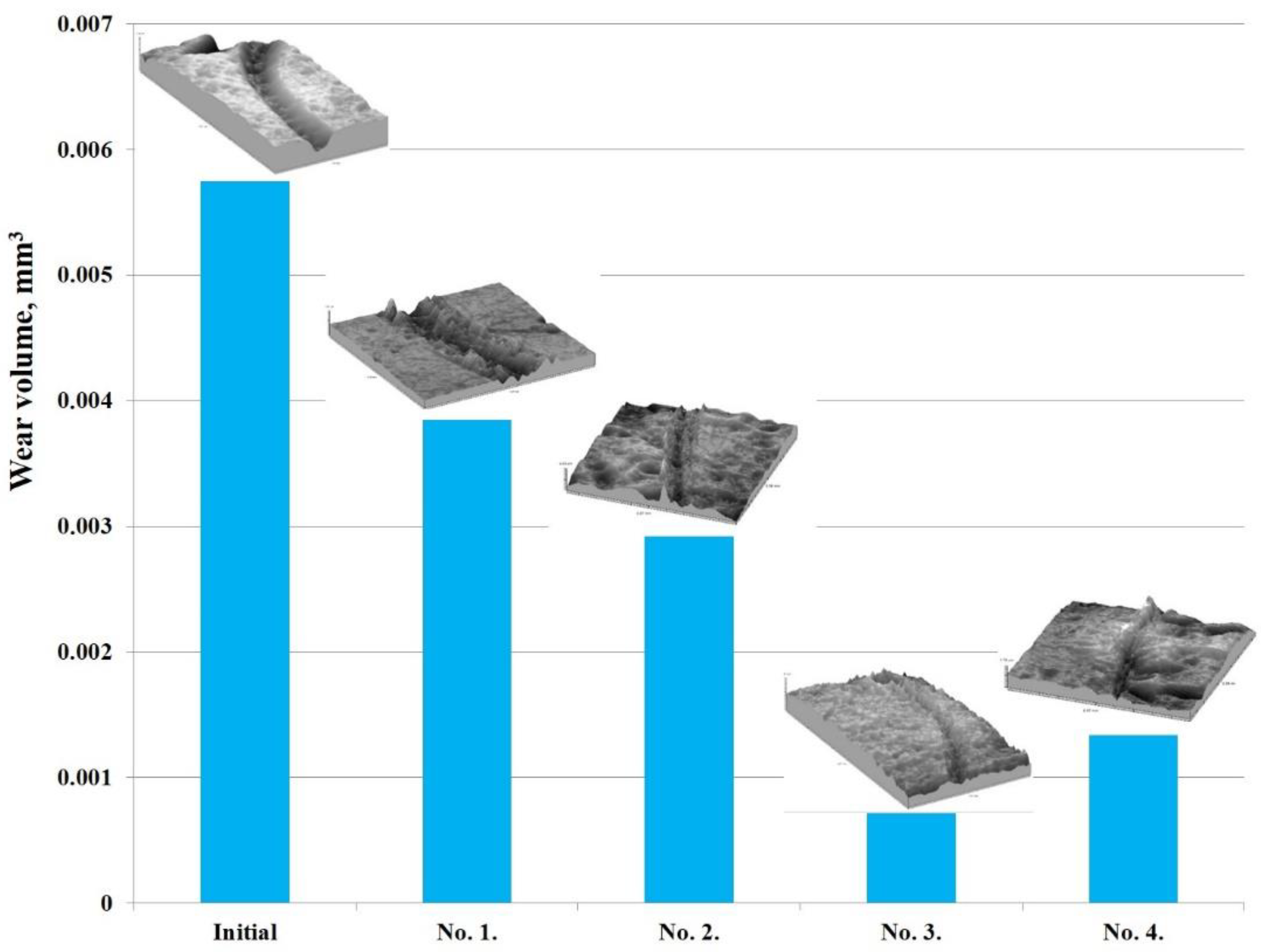
| Cycle | 1 | 2 | 3 | 4 | 5 | 6 | 7 | |||||||
|---|---|---|---|---|---|---|---|---|---|---|---|---|---|---|
| Samp. | U1, V | t1, s | U2, V | t2, s | U3, V | t3, s | U4, V | t4, s | U5, V | t5, s | U6, V | t6, s | U7, V | t7, s |
| No. 1 | 320 | 2 | - | - | - | - | - | - | - | - | - | - | - | - |
| No. 2 | 320 | 1 | 50 | 7 | 320 | 1 | - | - | - | - | - | - | - | - |
| No. 3 | 320 | 1 | 250 | 3 | 50 | 5 | 320 | 1 | 250 | 2 | 50 | 5 | 320 | 1 |
| No. 4 | 320 | 1 | 50 | 5 | 320 | 1 | 50 | 7 | 320 | 1 | 50 | 9 | 320 | 1 |
| Samples | Modulus of Elasticity, GPa | Hardness, GPa |
|---|---|---|
| Initial | 327 ± 14 | 3.6 ± 0.2 |
| No. 1 | 149 ± 5 | 5.7 ± 0.3 |
| No. 2 | 138 ± 5 | 6.9 ± 0.5 |
| No. 3 | 243 ± 6 | 9.1 ± 0.6 |
| No. 4 | 264 ± 7 | 8.8 ± 0.5 |
| No. | Samples | Coefficient of Friction | Wear Volume, 10−3 mm3 | Ra, µm |
|---|---|---|---|---|
| 1 | Initial | 0.5476 ± 0.0814 | 5.75 ± 0.41 | 0.044 ± 0.005 |
| 2 | No. 1 sample | 0.4888 ± 0.0677 | 3.84 ± 0.21 | 0.157 ± 0.014 |
| 3 | No. 2 sample | 0.3918 ± 0.0413 | 2.92 ± 0.15 | 0.059 ± 0.005 |
| 4 | No. 3 sample | 0.2305 ± 0.0497 | 0.72 ± 0.03 | 0.064 ± 0.007 |
| 5 | No. 4 sample | 0.2512 ± 0.0588 | 1.34 ± 0.08 | 0.098 ± 0.009 |
Publisher’s Note: MDPI stays neutral with regard to jurisdictional claims in published maps and institutional affiliations. |
© 2022 by the authors. Licensee MDPI, Basel, Switzerland. This article is an open access article distributed under the terms and conditions of the Creative Commons Attribution (CC BY) license (https://creativecommons.org/licenses/by/4.0/).
Share and Cite
Baizhan, D.; Rakhadilov, B.; Zhurerova, L.; Tyurin, Y.; Sagdoldina, Z.; Adilkanova, M.; Kozhanova, R. Investigation of Changes in the Structural-Phase State and the Efficiency of Hardening of 30CrMnSiA Steel by the Method of Electrolytic Plasma Thermocyclic Surface Treatment. Coatings 2022, 12, 1696. https://doi.org/10.3390/coatings12111696
Baizhan D, Rakhadilov B, Zhurerova L, Tyurin Y, Sagdoldina Z, Adilkanova M, Kozhanova R. Investigation of Changes in the Structural-Phase State and the Efficiency of Hardening of 30CrMnSiA Steel by the Method of Electrolytic Plasma Thermocyclic Surface Treatment. Coatings. 2022; 12(11):1696. https://doi.org/10.3390/coatings12111696
Chicago/Turabian StyleBaizhan, Daryn, Bauyrzhan Rakhadilov, Laila Zhurerova, Yuri Tyurin, Zhuldyz Sagdoldina, Meruyert Adilkanova, and Rauan Kozhanova. 2022. "Investigation of Changes in the Structural-Phase State and the Efficiency of Hardening of 30CrMnSiA Steel by the Method of Electrolytic Plasma Thermocyclic Surface Treatment" Coatings 12, no. 11: 1696. https://doi.org/10.3390/coatings12111696





